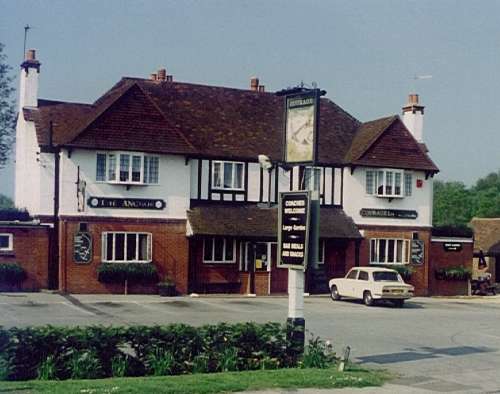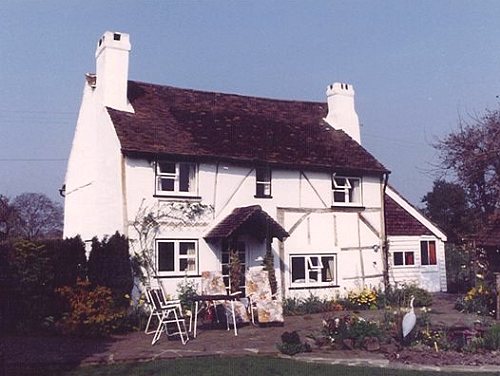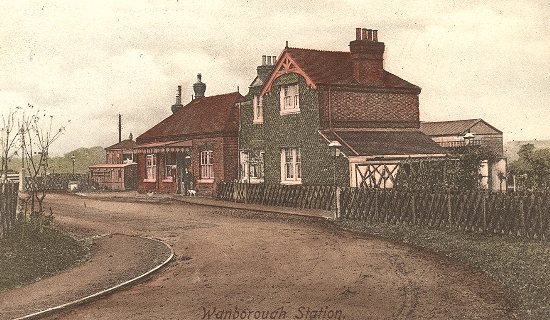| The Ancient Tithing of Frymlesworth
It might surprise some people that the name Normandy did not appear
in Surrey until 1604 when references were noted in the Court records of
the Manor of Cleygate to "Normandy Causeway" and "a messuage
with a garden in Normandy abutting upon More Meade in Asshe". Those
references were to areas of land now known as Normandy Common. At that
time the main settlement of the area was located around where the Anchor
public house used to stand (demolished in July 2000) and replaced with
a group of five houses, the address of which is appropriately named "Anchor
Close". It is clear from other entries in the Court Records that this
settlement was called Frymlesworth and was one of the two tithings of the
Manor, the other being Henley.

- The Anchor in May 1989
The location of Frymlesworth
Most references to Frymlesworth in the Court Records concern holdings of
land now identified as being in the vicinity of Anchor Close. For example:
"Prichelles scytuate in Frymlesworth within the parish of Ash".
That property is identified and is still called "Pritchells",
located in Wells Lane on the opposite side of the A323 to that of Anchor
Close. Another example is: "one Little Meade in Frymlesworth called
Westmeade otherwise Hewersgrove". That land has been identified as
"West Field" on the 1839 Tithe Map, located at the rear of what
is now the CCB garage. There are suggestions elsewhere that West Mead was
once part of the Open Field System before enclosure.

- Pritchells
Other holdings within the Manor of Cleygate, such as Marlyns (now Glaziers
of Glaziers Lane) and Wheybournes (the Mariners holding of Guildford Road
adjoining Normandy Garage), are recorded as being in Frymlesworth indicating
that the Tithing of Frymlesworth included land up to the boundary of the
Manor of Wyke. The extent of the Tithing is further indicated by a statement
in a survey of the Manor of Cleygate between 1547 and 1549 concerning the
messuage of one Robert Purse "in the hamblett of Frymlesworth extending
in length from the land of John Gillerd unto the Quenes Waye and in breadth
betweene the land sumtyme of John of Henley of the one parte and the heath
of the other parte". The Queen's Way is now Pirbright Road. Also,
there is a reference to "one close in Frymlesworthe called Grove at
Heath"; identified as Grovers Heath on the Tithe Map located to the
north-west of the Manor
There are seven references to Frymlesworth in that survey, the location
of which have been identified. There was good reason for the main settlement
being where it was because it lay on a strip of alluvium more fertile and
friable than the heavy clay in the rest of the valley. It was not until
the coming of the railway in the mid 1850s and the building of Wanborough
Station in 1891 that the centre of gravity of the village began to shift
westwards to the crossroads area of Guildford Road with Glaziers Lane.

- Wanborough Station about 1913
The name of Frymlesworth
The earliest written reference is in 1225 when it was recorded as Fremelesworth.
However, the name is certainly much older since after the Conquest, Old
English elements were not generally used in place naming. The variant form
of the name descends more or less intact from 1225 to 1548. Thus, we have:
Fremelesworth (1225), Frumlesworth (1255), Fremesworth (1263), Framlesworth
(1305), Frymlesworth in 1548 and finally Frimlesworthe in 1604. The name
is formed of two elements, namely Frymles and Worth. The second element
means an enclosure or protected homestead. The first element could refer
to a person (Frimle or Fremle) or the settlement of Frimley and if so would
mean "the enclosure belonging to Frimley" which would infer a
later settlement to that of Frimley in north-west Surrey. In 1548 Frymlesworth
was described as "infra parochiam de Asshe" (under the parish
of Ash). Ash was in the Hundred of Woking (now Old Woking), which then
was called "Wockinges" in 1086 (Domesday Book). The Hundred Court
was held on the verge of the Hundred at Harmes Hatch.
The name of Frimley
The name of Frimley has been recognisably similar to the modern form since
the year 933 when it was rendered as Fremeley. By 1203 it was Fremle, and
in 1445 was Fremley, attaining its present form of Frimley in 1575. The
name is formed from two elements meaning the woodland clearing of a man
named Frem(m)a. The element Ley, Leah or Lee only later came to be applied
to a field or meadow.
Frimley, although originally a hamlet of Ash in the Woking Hundred, was
yet always reckoned to be in Godley Hundred, probably because the Manor
of Frimley belonged to Chertsey Abbey. According to the historian Aubrey,
the Hundred Court was held at Hardwick in Chertsey
The retention of ancient place names
Frymlesworth is described in the English Place Names of Surrey as (lost),
which is true. Its disappearance from the geographic arena could be laid
at the door of several and otherwise reliable reference sources, including
the Victoria County History of Surrey. Such sources have contributed to
the confusion of the name Frymlesworth and its associated derivations with
those of Frimley located several miles to the north. Closer examinations
of primary sources indicates, that such speculation about Frymlesworth
is based on nothing more than a similarity of Saxon named elements notwithstanding
the fact that the derivation of Frimley has remained remarkably unchanged
since AD 933.
However, it is perhaps questionable as to whether the retention of the
name Frymelsworth as a place name would be welcome or retained today.
Of interest is a reference in the Manor of Cleygate Records of 1604: "William
Sherrett held land in Frimlesworthe and Constance Hawarde, John Ticknor
and his wife Alice were admitted to a messuage with a garden in Normandy
abutting upon More Meade in Asshe". Thus in 1604 the names of Frimlesworthe
and Normandy existed side by side. Perhaps it was more convenient from
1604 onwards to drop Frimlesworthe and use the name "Normandy"
for reasons of both the written and spoken word?
Jack Kinder
References:
The Court Records of the Manor of Cleygate.
A Survey of the Manor of Cleygate 1547-49, Harley Roll C12
The Victoria County History of Surrey
Tithe Award Map for Normandy Tithing, 1844
English Place Names, Elements English Place Names Society, Cambridge UP
1956
- Wikipedia links
- English Place-Name Society
- Tithe
|